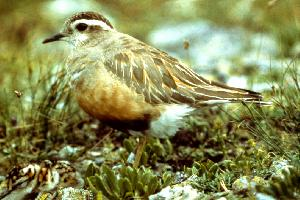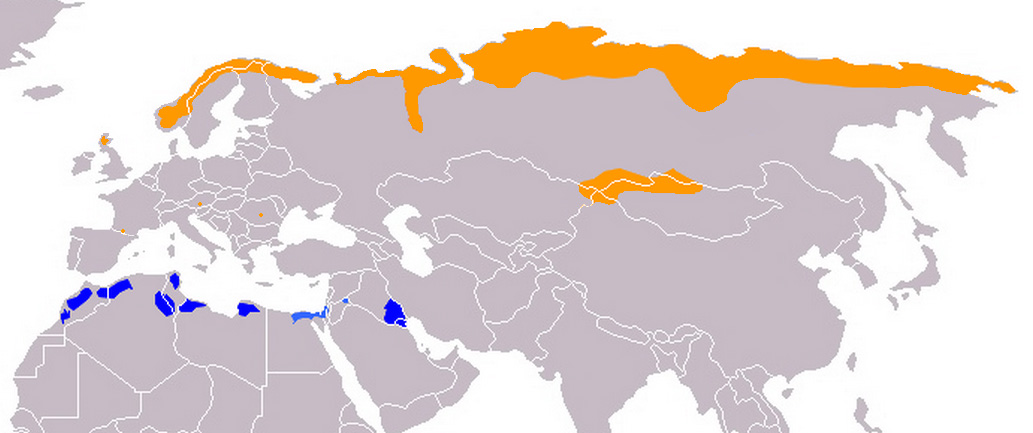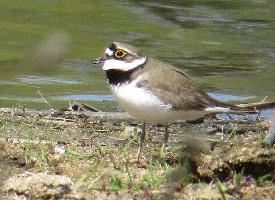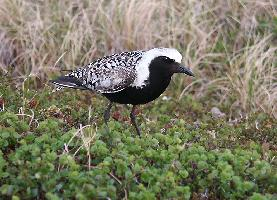
Descrierea animalului
The Eurasian dotterel (Charadrius morinellus) is a fascinating and somewhat elusive bird species belonging to the plover family, Charadriidae. Renowned for its distinctive plumage and intriguing behaviors, this bird is a captivating subject for birdwatchers and ornithologists alike. The Eurasian dotterel inhabits the mountainous and tundra regions across Eurasia, embarking on remarkable migratory journeys that showcase its adaptability and resilience.Physical Description:
The Eurasian dotterel is a medium-sized plover, measuring approximately 20-22 cm in length, with a wingspan ranging from 57 to 64 cm. It has a relatively compact body, short legs, and a short, straight bill. The species exhibits a unique reversed sexual dimorphism, a characteristic not commonly observed in birds, where the females are more brightly colored than the males. During the breeding season, females flaunt a striking plumage with a chestnut breast band, bordered by white and black lines. Their upperparts are predominantly grey with brownish tones, blending seamlessly into the tundra landscape. Males, while still attractive, have more subdued coloration, primarily designed for camouflage while they undertake the primary role of incubating eggs and caring for the young. Juveniles resemble the adult males but with a more mottled appearance.
Habitat and Distribution:
Eurasian dotterels inhabit open, often barren landscapes, including alpine meadows, tundra, and heathlands. They show a preference for areas with sparse vegetation, which aids in their foraging. During the breeding season, they are found in the high Arctic regions of Europe and Asia, from Scandinavia across to Siberia. With the approach of winter, they migrate to more temperate zones, spending the non-breeding season in North Africa, the Middle East, and parts of Asia, where they can be found in similar open habitats, including semi-deserts and grasslands.
Behavior and Diet:
Eurasian dotterels are primarily ground foragers, with a diet that consists of insects, larvae, small invertebrates, and occasionally seeds. They employ a run-and-pause technique to hunt, a common method among plovers, where they sprint across the ground before stopping abruptly to snatch prey. This bird is known for its social nature, especially outside the breeding season when they form flocks that can number in the dozens. During migration and wintering, these flocks provide safety in numbers from predators.
Breeding and Reproduction:
The breeding season begins as the snow melts in their high-altitude habitats, typically from late May through July. The Eurasian dotterel’s breeding behavior is particularly noteworthy due to its role reversal; the more vividly colored females compete for the attention of males, who are responsible for nest building, incubation, and chick-rearing. Nests are simple scrapes on the ground, often lined with bits of vegetation. A typical clutch consists of 2-3 eggs, which the male incubates for about 21-28 days. The chicks are precocial, leaving the nest shortly after hatching, though they remain under the father's care until they are capable of flight.
Conservation Status:
The Eurasian dotterel is currently classified as Least Concern by the International Union for Conservation of Nature (IUCN), indicating that it does not face any immediate threat of extinction. However, like many migratory species, it is vulnerable to habitat degradation, climate change, and human disturbances, which could impact its populations in the future. Conservation efforts focused on protecting its breeding, migratory, and wintering habitats are essential to ensure the continued survival of this unique and intriguing bird species.
Harta răspândirii

Animale similare
Fotografii noi cu animale
Top 10 animale
- Dolphin gull (Leucophaeus scoresbii)
- Diana monkey (Cercopithecus diana)
- Moustached guenon (Cercopithecus cephus)
- Greek tortoise (Testudo graeca)
- Stone loach (Barbatula barbatula)
- Galápagos tortoise (Geochelone nigra complex)
- Japanese macaque (Macaca fuscata)
- Russian tortoise (Testudo horsfieldii)
- Common flying dragon (Draco volans)
- Galápagos penguin (Spheniscus mendiculus)


